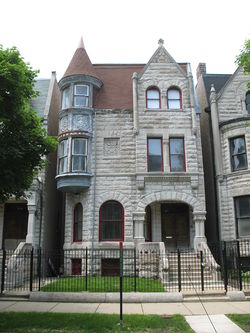
Ida B. Wells-Barnett

By Megan McKinney
As mentioned in our most recent Classic Chicago Dynasties article, when Ida Wells returned to America from a lecture tour in Great Britain in 1893, she went out to Chicago to protest the lack of a Black presence at the Columbian Exposition.

Ferdinand Barnett
There she met Chicago lawyer Ferdinand Lee Barnett, a Northwestern University-educated widower with an avid interest in social justice.
Ten years older than Ida, Ferdinand Barnett had a prosperous legal practice and was publisher of The Conservator, the city’s first Black newspaper. Ida had had many beaux through the years but none who tempted her to form a lasting relationship. At last, here was the perfect partner, but she still had much to accomplish.

She accepted the offer of a part-time job with The Conservator, while continuing to write pamphlets attacking lynching. She also established the Ida B. Wells Club in Chicago, the first Black women’s civic club. When asked to return to Great Britain for another speaking tour, Ida approached the Chicago Inter-Ocean–a successful white daily paper and the only one to have taken a strong anti- lynching stand–and received an assignment to file reports during her tour.

Other American papers ran articles about her British campaign based on the Inter-Ocean pieces and articles in English papers, including accounts of her feud with Woman’s Christian Temperance Union president Frances E. Willard, who was visiting England at the same time.
 After returning to America, Ida spent a year traveling through the North organizing groups to oppose lynching. Finally, on June 27, 1985, Ida—then nearly 33—married Ferdinand Barnett, having purchased The Conservator from him only days before and becoming its editor and publisher.
After returning to America, Ida spent a year traveling through the North organizing groups to oppose lynching. Finally, on June 27, 1985, Ida—then nearly 33—married Ferdinand Barnett, having purchased The Conservator from him only days before and becoming its editor and publisher.

Ida and Ferdinand lived in this stately mansion at 3624 S. Martin Luther King Drive from 1919 to 1930.

She hyphenated her name to Wells-Barnett and became mother to two step-children, 11-year-old Ferdinand Jr. and Albert, age nine, who were cared for by Ferdinand’s mother who lived in the same household.

Ida with Charles, Herman, Ida Jr. and Alfreda in 1909.
Charles Barnett was born nine months after their wedding, followed by Herman, a year later, and then Ida Jr. and Alfreda. After Herman’s birth, Ida gave up the newspaper but continued her activism. Her increasing militancy repelled many other Black leaders and she in turn found them—particularly Booker T. Washington–lacking in fire. Because of this militancy and her candor about rape and interracial sex, Booker, rather than Ida, succeeded Ida’s friend Frederick Douglass as “leader of the Afro-American race.”
 Ida lived until March 25, 1931.
Ida lived until March 25, 1931.

The institutional honors have been coming in, with a postage stamp in 1990.

In February 2019, Congress Parkway, a major street in downtown Chicago .was renamed Ida B. Wells Drive.

The following month, she was honored by Women’s History Month.
This segment concludes Publisher Megan McKinney’s Classic Chicago Dynasty series on Ida B. Wells.
Edited by Amanda K. O’Brien
Author Photo: Robert F. Carl







